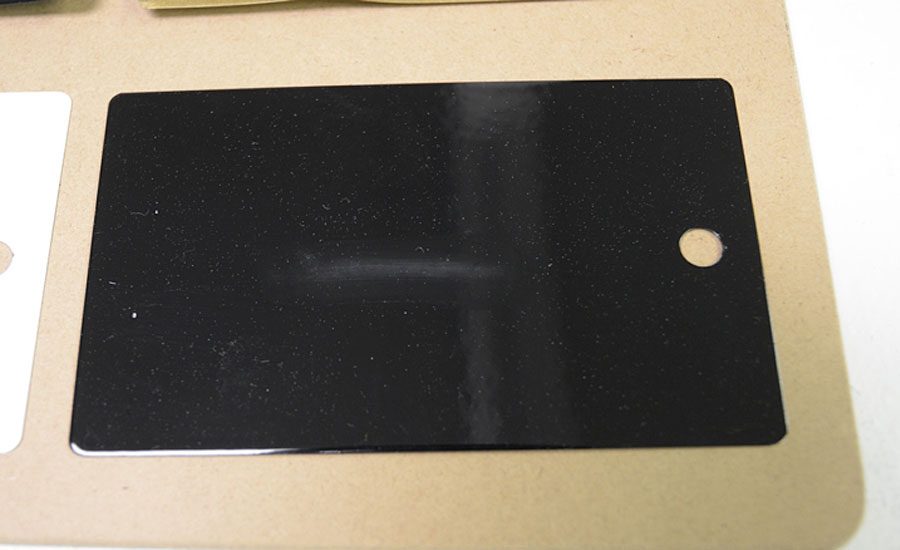Common Challenges to Batch Powder Coating Start-Ups

Figure 1 - Interior corner is inadequately covered in powder due to insufficient ground

Figure 2 - Bruce check rack for sufficient grounding

Figure 3 - Mossy Finish resulting from spraying too thick a coating of powder

Figure 4 - Sample after MEK rub test, showing finish rubbed off due to inadequate cure




Investing in batch powder coating equipment is an exciting step in expanding a production shop's business. By the time all the pieces arrive and are installed - the pretreatment equipment, dry-off oven, spray booth, powder guns, and curing oven - it's tempting to dive in right away. They look so easy to use on the internet!
However, before you start using it, make sure you've received training on how to operate and maintain all of your new equipment. Failing to do so will cause the equipment to under-perform, and may even damage it!
If you haven't received training yet, attend an established powder coating training class, or hire a consultant to train you at your shop. If this kind of formal training is impractical, ask your powder and chemistry suppliers to send technicians to help you get off to a good start.
Gaining knowledge of how the equipment should work, and what you need to do to maintain it, will help you navigate the key steps in your coating process. What you need to know can be categorized under four headings: Application, Product Flow, Process and Preventative Maintenance.
Batch Application of Powder Coating
Before any application of powder coating begins, the parts need to be clean and ready for powder to adhere. This idea sounds simple, but you may have to try a couple of different chemicals or detergents to identify the right fit for your situation.
In order for the surface to be ready to accept powder, your parts need to be clean, dry, streak free, oil-free, and fiber free. (Note - shop towels and tack rags leave fibers.)
Depending on your finish, you may need to blast or phosphatize your part. To check the surface, run a clean hand over the parts before you start coating. You're checking for streaks, wet patches or oily spots.
Here are some fixable issues we've seen new powder coaters suffer:
Insufficient Ground: The powder isn't sticking to the parts uniformly, or it won't go into the corners of certain parts. Address this issue by burying a 6’ to 10’ grounding rod close to the spray booth and using a heavy gauge ground strap attached to it to assure that parts are well-grounded. You need clean hooks and a clean rack if you are clamping the ground strap to your cart.
The Powder Gun Won’t Spray Evenly: An inconsistent amount of powder is spraying out of the gun. Check the gun manufacturer’s recommended settings or ask your powder supplier’s technical sales for advice. You may be getting the wrong amount of air. Incorrect settings can be troublesome and easy to overlook.
Bad Finish Due to the Amount of Powder on the Part: Uneven powder application can cause finishes to be too thin or too thick. The typical mil thickness of applied powder is 2-3 mils after baking. Achieve this result by spraying powder evenly with about a 50% spray overlap as you cover the part. Try to make the freshly applied powder look like felt. If the powder looks like chalk on a chalkboard, or it seems like you can see through it, apply a heavier coating for best results. If it looks like moss, then you may have applied too much and may get an orange-peel look after baking.
Clumpy Powder: Powder that clumps and spits from the gun is difficult to apply evenly. Weather conditions can affect powder application. Rainy, damp or high-humidity weather can cause powder to clump and spit from the gun, especially if your shop isn’t heated or cooled. Storing powder in a cool, dry environment may reduce this problem.
Finish Seems Inadequately Cured: The surest way to test cure is with a MEK rub test. Extremely cold temperatures outdoors can give your parts a lower temperature. Colder parts may require extra baking time or a slightly higher curing temperature. Consider storing your parts in a climate controlled area for at least an hour before spraying.
Fish-Eye or Other Surface Defect Issues: Airborne contaminants are often the culprit to surface defects. Make sure the compressor supplies dry, oil-free air to the powder gun. Look for work stations near the coating line that have WD40, caulk or other products that emit solvent vapors. Isolate your coating equipment from blasting, sanding and welding stations. Check the air flowing through the spray booth. If the booth has diesel fumes coming into it from a generator, welding rig or forklift–or if new asphalt is being poured nearby–the fumes can cause temporary problems that may be hard to trace.
Product Flow
It's a good idea to plan racks and holding areas in advance. But sometimes you have to adjust your thinking once you see your coating process taking place. You will need to be flexible with rack designs and remember the need for staging areas for parts that are in-process.
Initially, small production runs will help you develop a process that can be repeated with consistent results. Don’t overdo It - if you can’t get great results on a small scale, you certainly can’t get them on a large scale. Production can increase after employees are comfortable with the coating process and understand each of the steps. Don’t expect to do 5,000 flawless parts your first week after start-up. It’s much easier to increase throughput slowly than to be stuck with a large number of re-works right from the start.
The desire to go fast can cause unique problems related to product flow. Often new batch coaters report parts suffering damage in handling. This issue can be caused by workers unloading the parts before cool enough to be moved safely, often in an attempt to meet throughput goals. Keep your expectations realistic and avoid quality problems that are easily preventable.
Batch Powder Coating Process
Get familiar with the manufacturer's specifications of the powder and pretreatment chemistry that you plan to use. These documents will help you troubleshoot issues in your powder coating process.
These provided guidelines will include recommendations for: dwell times for chemicals, thickness guidelines for powder in mils, cure time and temperature for powder, and cool-down requirements before parts can be packed.
By following the experts’ recommendations, you will start to see how long it takes to produce a good part with a quality finish. By working further with the production schedule, you can find out where bottle necks occur and where you may need to move staff around to help with long rack loading and unloading times.
Cure times can vary depending on your metal thickness, outside temperature and powder specifications. Because of these variables, batch your jobs thoughtfully. Thin metal may only need 12 minutes at curing temperature, while ¼ inch steel rebar might take up to 30 minutes. Although it might not seem like a big deal, 18 minutes of variance is a hefty difference if you intend to cure both parts at the same time. You may run into over-bake issues with the thinner parts. You’re better off batching similar parts together for curing. Bake all the small or thin parts at one schedule, and then do the thicker parts with a different one. Remember, although powder may cure quickly at a desired temperature, heavy parts may take a much longer time to reach that temperature.
If you want to understand the quality of the finish you have created, you should test your parts on your own. Effective tests that you can do in-house include: mil thickness, adhesion, MEK rubs (to test cure completeness), and impact resistance. Running tests like these will ensure the parts are good before they go to the customer. Check with the powder manufacturer’s technical rep before making any adjustments to your process.
Consider quality assurance as a subprocess all its own. As you develop your finishing process, find a place for those tests that can assure quality.
Preventative Equipment Maintenance
Preventative maintenance is an area where an alarming number of shops struggle. Failing to invest in a maintenance plan puts new equipment at risk. Filters, bearings and the recommended lubricant are all relatively inexpensive, and easy to get from your equipment provider. Proper maintenance isn’t always cheap, but it is always much cheaper than new equipment.
When you get new powder coating equipment, there are usually a number of PM routines that need to be adopted. If you don’t have a maintenance department, you need to designate an employee as the maintenance supervisor for your new coating equipment and keep that position responsible for maintenance-related downtime and issues.
New powder coating equipment will require a number of routines for preventative maintenance. If you don’t have a maintenance department, designate an employee as the maintenance supervisor for your new coating equipment. Keep that position responsible for maintenance-related downtime and issues.
Keeping your powder coating equipment clean and maintained is the key to your system’s longevity. Proper maintenance can help a system last 3-5 years longer, with 20-30% less downtime during regular production hours. This prevention can also significantly reduce costs associated with poor finish quality caused by unmaintained equipment.
If you want to get the most from your equipment and expendables, take care of them and stay organized:
- Keep critical spare parts on hand for emergencies. Also stock small parts and expendables like filters, grease, and belts.
- Store your powder in a climate-controlled environment and routinely rotate stock.
- Have one easy-to-access place for all of the contact information for your suppliers’ technical support personnel.
- Stick to a schedule for everything: from filter changes, to lubrication, to booth cleaning, to rack and hook burn-off.
- Don’t wait for something to break before setting a good preventative maintenance program in place.
You Can Succeed
As a new batch powder coater, these challenges are common, but you can meet them! By preparing your processes, and educating yourself on equipment maintenance, you will be able to skip many of the growing pains, and get your coating off to the right start.
References
1 Other ways to tell a powder coated finish is inadequately cured: the surface is tacky, soft to the touch (per pencil hardness test), color is off (clear powder goes on white, should bake clear), orange peel, incorrect higher gloss, delamination.
For more information, visit https://www.reliantfinishingsystems.com.
Looking for a reprint of this article?
From high-res PDFs to custom plaques, order your copy today!











